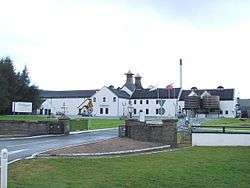Dalwhinnie
| Dalwhinnie | |
| Scottish Gaelic: Dail Chuinnidh | |
 Dalwhinnie distillery |
|
 Dalwhinnie |
|
| OS grid reference | NN634849 |
|---|---|
| Council area | Highland |
| Country | Scotland |
| Sovereign state | United Kingdom |
| Post town | Dalwhinnie |
| Postcode district | PH19 |
| Dialling code | 015282 |
| Police | Scottish |
| Fire | Scottish |
| Ambulance | Scottish |
| EU Parliament | Scotland |
Coordinates: 56°56′10″N 4°14′38″W / 56.936°N 4.244°W
Dalwhinnie (/dælˈhwɪni/ dal-HWIN-ee; Scottish Gaelic: Dail Chuinnidh) "Meeting Place" is a small village in the Scottish Highlands.
Location
Dalwhinnie sits at an altitude of 351 m. It is one of the coldest villages in the UK, having an average annual temperature of 6.6oC, making it suitable for winter walking and mountaineering. It is north of Drumochter, just off the A9 road from Perth to Inverness and has been bypassed since 1975. It is about 2 to 2½ hours drive from both Edinburgh and Glasgow, 25 miles from Aviemore, 13 from Newtonmore and 17 from Kingussie.
Dalwhinnie railway station lies on the Highland Main Line from Perth to Inverness.
Climate
Dalwhinnie experiences a borderline subpolar oceanic climate (Cfc), with frequently overcast skies, cool temperatures and rainfall throughout the year. Sunshine here averages only 1032 hours, which is one of the lowest in the United Kingdom. Dalwhinnie holds the UK low temperature records for the months of June, September and October.[1] In addition it also holds Scotland's record for the lowest April daytime maximum temperature of −1.0 °C (30.2 °F) in 1975, and the record lowest October temperature for Scotland of -11.7°C.[2] For the 1951-1980 observation period it averaged a temperature of 6.3 °C (43.3 °F) compared to Braemar's 6.4 °C (43.5 °F),[3] making Dalwhinnie one of the coldest inhabited places in the British Isles. In fact, according to the 1981-2010 observation period Dalwhinnie is the coldest place in the UK below 500 metres above sea level, with a mean temperature of 6.6 °C (43.9 °F),[4] lower than its closest rivals Leadhills and Braemar which both have mean temperatures of 6.8 °C (44.2 °F) for this period. The lowest temperatures in recent years have been −15.8 °C (3.6 °F) in January 2010[5] and −16.1 °C (3.0 °F) during December 2010. Winter snowfall can be heavy, with accumulations often exceeding 30 cm.[6]
| Climate data for Dalwhinnie, elevation 359m, 1951-1980 (Sunshine 1931-1960) (Extremes 1951-present) | |||||||||||||
|---|---|---|---|---|---|---|---|---|---|---|---|---|---|
| Month | Jan | Feb | Mar | Apr | May | Jun | Jul | Aug | Sep | Oct | Nov | Dec | Year |
| Record high °C (°F) | 11.3 (52.3) |
11.1 (52) |
17.2 (63) |
21.0 (69.8) |
25.6 (78.1) |
28.8 (83.8) |
30.0 (86) |
27.2 (81) |
23.3 (73.9) |
26.2 (79.2) |
15.6 (60.1) |
13.3 (55.9) |
30.0 (86) |
| Average high °C (°F) | 1.7 (35.1) |
2.4 (36.3) |
5.2 (41.4) |
9.0 (48.2) |
12.8 (55) |
15.8 (60.4) |
16.7 (62.1) |
16.4 (61.5) |
13.7 (56.7) |
9.2 (48.6) |
5.0 (41) |
2.5 (36.5) |
8.1 (46.6) |
| Average low °C (°F) | −3.1 (26.4) |
−3.4 (25.9) |
−1.9 (28.6) |
0.0 (32) |
3.1 (37.6) |
6.1 (43) |
8.2 (46.8) |
8.0 (46.4) |
6.2 (43.2) |
3.0 (37.4) |
−0.2 (31.6) |
−2.3 (27.9) |
1.5 (34.7) |
| Record low °C (°F) | −25.6 (−14.1) |
−26.7 (−16.1) |
−20.8 (−5.4) |
−10.6 (12.9) |
−8.8 (16.2) |
−5.6 (21.9) |
−1.7 (28.9) |
−2.8 (27) |
−6.7 (19.9) |
−11.7 (10.9) |
−19.2 (−2.6) |
−24.3 (−11.7) |
−26.7 (−16.1) |
| Average precipitation mm (inches) | 133.0 (5.236) |
97.0 (3.819) |
70.0 (2.756) |
78.0 (3.071) |
69.0 (2.717) |
66.0 (2.598) |
90.0 (3.543) |
85.0 (3.346) |
103.0 (4.055) |
143.0 (5.63) |
125.0 (4.921) |
158.0 (6.22) |
1,217 (47.913) |
| Mean monthly sunshine hours | 27 | 51 | 92 | 118 | 158 | 150 | 121 | 115 | 91 | 61 | 31 | 17 | 1,032 |
| Source #1: Globalbioclimatics/S.Rivas-Martínez [7] | |||||||||||||
| Source #2: DMI/Danish Meteorology Institute - page 254 [8] | |||||||||||||
Tourism
The area is teeming with wildlife and there are walks along the River Truim and in Cairngorm and Monadhliath Mountains in the Cairngorm National Park.[9]
Dalwhinnie is on the Sustrans National Cycle Route No. 7, Glasgow to Inverness. There are several cycle routes in the area including one alongside Loch Ericht.
Distillery
Diageo owns the local distillery, the highest-elevation working distillery in Scotland. Dalwhinnie Single Malt is a light, heathery whisky.
Activities
- Golf
- Walking
- Mountain Biking
- Watersports
- Horse Riding and Pony Trekking
- Fishing
- Shooting
External links
- Newtonmore Riding Centre Website
- Forestry Commission Scotland. Wolftrax Mountain Biking Centre Link
- Dalwhinnie Voices
See also
- Centre points of the United Kingdom
- Battle of Invernahavon - the remnants of a party of Clan Cameron raiders escaped via Dalwhinnie after their defeat by the Chattan Confederation south west of Newtonmore in this 14th century battle.
References
- ↑ "Monthly Cold records". TORRO.org. Retrieved 24 April 2012.
- ↑ "Monthly records". UKMO. Retrieved 24 April 2012.
- ↑ "Average Temperature". Scotclim. Retrieved 24 April 2012.
- ↑ "Dalwhinnie climate information". Met Office. 1 May 2014. Retrieved 16 July 2015.
- ↑ Rogers, Simon (7 January 2010). "Jan2010 temperature". The Guardian. London. Retrieved 24 April 2012.
- ↑ "Dec2010 temperature". UKMO. Retrieved 24 April 2012.
- ↑ "Temp/Rain 1901-1950". Globalbioclimatics. Apr 2012. Retrieved 24 April 2012.
- ↑ "Sunshine 1931-1960" (PDF). DMI.DK. Apr 2012. Archived from the original (PDF) on 16 January 2013. Retrieved 24 April 2012.
- ↑ "Cairngorms National Park". Cairngorms National Park Authority. Retrieved 16 July 2015.